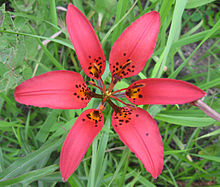
Lilium is a genus of herbaceous flowering plants growing from bulbs, all with large and often prominent flowers. They are the true lilies. Lilies are a group of flowering plants which are important in culture and literature in much of the world. Most species are native to the Northern Hemisphere and their range is temperate climates and extends into the subtropics. Many other plants have "lily" in their common names, but do not belong to the same genus and are therefore not true lilies.

Lilium bulbiferum, common names orange lily, fire lily,Jimmy's Bane,tiger lily and St. John's Lily, is a herbaceous European lily with underground bulbs, belonging to the Liliaceae.

Lilium candidum, the Madonna lily or white lily, is a plant in the true lily family. It is native to the Balkans and Middle East, and naturalized in other parts of Europe, including France, Italy, and Ukraine, and in North Africa, the Canary Islands, Mexico, and other regions. It has been cultivated since antiquity, for at least 3,000 years, and has great symbolic value since then for many cultures. It is susceptible to several virus diseases common to lilies, and especially to Botrytis fungus. One technique to avoid problems with viruses is to grow plants from seed instead of bulblets.

Lilium longiflorum, often called the Easter lily, is a species of plant endemic to both Taiwan and Ryukyu Islands (Japan). Lilium formosanum, a closely related species from Taiwan, has been treated as a variety of Easter lily in the past. It is a stem rooting lily, growing up to 1 m high. It bears a number of trumpet shaped, white, fragrant, and outward facing flowers.

Lilium martagon, the martagon lily or Turk's cap lily, is a Eurasian species of lily. It has a widespread native region extending from Portugal east through Europe and Asia as far east as Mongolia.
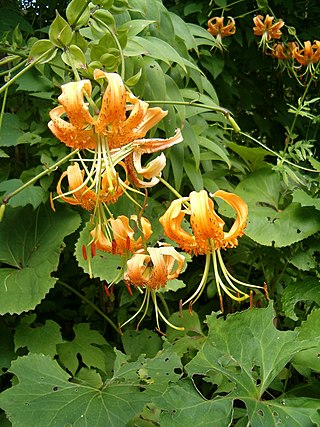
Lilium henryi, sometimes called tiger lily or Henry's lily, is a native lily of the mountains of central China. The flowers are orange, spotted black, and unscented. The petals are recurving, and eventually resemble those of the more widespread Turk's-cap lily.
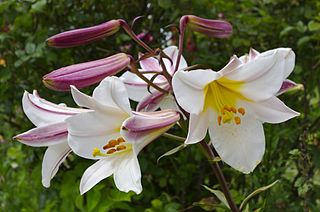
Lilium regale, called the regal lily, royal lily, king's lily, or, in New Zealand, the Christmas lily, is a species of flowering plant in the lily family Liliaceae, with trumpet-shaped flowers. It is native to the western part of Sichuan Province in southwestern China, and cultivated elsewhere as an ornamental. It was introduced to England in 1903 by Ernest Henry Wilson.

Lilium canadense, commonly called the Canada lily, wild yellow-lily, or meadow lily, is a native of eastern North America. Its native range extends from Ontario to Nova Scotia south to Georgia and Alabama. It is most common in New England, the Appalachian Mountains, and the Canadian Maritimes. It is also cultivated as an ornamental in Europe and other places.

Cypripedium acaule is a species of flowering plant in the orchid family Orchidaceae native to eastern North America. It is currently the provincial flower of Prince Edward Island, Canada, and the state wildflower of New Hampshire, United States.

Lilium 'Stargazer' is a hybrid lily of the 'Oriental group'. Oriental lilies are known for their fragrant perfume, blooming mid-to-late summer. Stargazers are easy to grow and do best in full sunlight. They have a fast growth rate and should be planted in full sun in well-drained loamy or sandy soil. When mature, 'Stargazers' can grow to a height of 36 inches with a spread of 10 to 14 inches with 2 to 8 flowers per stem.

Hemerocallis fulva, the orange day-lily, tawny daylily, corn lily, tiger daylily, fulvous daylily, ditch lily or Fourth of July lily, is a species of daylily native to Asia. It is very widely grown as an ornamental plant in temperate climates for its showy flowers and ease of cultivation. It is not a true lily in the genus Lilium, but gets its common name from the superficial similarity of its flowers to Lilium and from the fact that each flower lasts only one day.
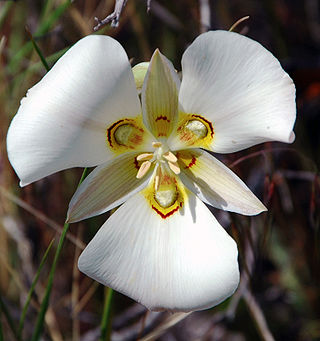
Calochortus nuttallii, also known as the sego lily, is a bulbous perennial plant that is endemic to the Western United States. The common name of sego comes from a similar Shoshone word. It is the state flower of Utah.

Lilium superbum is a species of true lily native to the eastern and central regions of North America. Common names include Turk's cap lily, turban lily, swamp lily, lily royal, or American tiger lily. The native range of the species extends from southern New Hampshire, Massachusetts, and New York, west to Illinois, Missouri, and Arkansas, and south to Georgia, Alabama, Mississippi, and Florida.
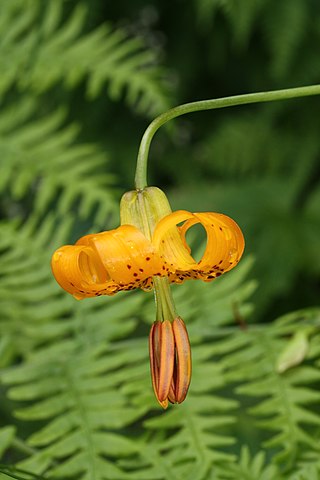
Lilium columbianum is a lily native to western North America. It is also known as the Columbia lily, Columbia tiger lily, or simply tiger lily.

Prosartes trachycarpa, the roughfruit fairybells, rough-fruited fairybells or rough-fruited mandarin, is a North American species of plants in the lily family. The species is widespread, known from British Columbia to Ontario and south to Arizona and New Mexico. One isolated population was reported from Isle Royale in Lake Superior.

Lilium occidentale is a rare North American species of lily known by the common name western lily. Its species name 'Occidentale' means 'westernmost' and refers to its location along the West Coast. It is native to northwestern California and southwestern Oregon. It grows in coastal prairie habitat, swamps and stagnant bogs with Drosera species, bluffs and sandy cliffs, and seaside spruce forests. This rare wildflower is limited in distribution and directly endangered by a number of environmental factors. It is a federally listed endangered species and it is listed as endangered by the states of California and Oregon.

Lilium iridollae is a species of Lilium or lily. It is a perennial forb. This species is considered one of five known Lilium species native to specific sites in the United States' southeast region. In 1940, this species was discovered by Mary Henry in its habitat. She named the lily in reference to a "pot of gold at the end of the rainbow".

Liparis liliifolia, known as the brown widelip orchid, lily-leaved twayblade, large twayblade, and mauve sleekwort, is a species of orchid native to eastern Canada and the eastern United States. It can be found in a variety of habitats, such as forests, shrublands, thickets, woodlands, and mountains. The orchid is considered globally secure, but it is considered rare or endangered in many northeastern states.
